Shoulder Care
The orthopedic surgeons at Great Lakes Orthopedics & Sports
Medicine, P. C. can evaluate your shoulder condition and provide the customized treatment plan to get you back to enjoying life!!
Broken Collarbone
Shoulder Specialists In The Greater St. John, Crown Point and Lowell, Areas
The orthopedic surgeons at Great Lakes Orthopedics & Sports Medicine, P. C. treat shoulder conditions and injuries at their 3 convenient offices in
St. John, Crown Point and Lowell, Indiana. Our orthopedic physicians are specially-trained in treating shoulder conditions and injuries. As leaders in orthopedic care, we provide minimally invasive and innovative treatment options, as well as utilizing state-of-the art technologies, to create unique and individualized care plan designed to get you back on your road to recovery and regaining an active lifestyle!!
FAQs on Broken Collarbone
Broken Collarbone
A broken collarbone is a break in the clavicle, the bone in the upper chest that connects the breastbone to the shoulder blade. Such breaks are relatively common, especially in babies, adolescents, and athletes. A broken collar bone can occur in several ways, but the most common involves some kind of trauma, such as falling, being hit directly on the shoulder itself, or involvement in an automobile accident.
Cause & Symptoms
Cause
Clavicle fractures are often caused by a direct blow to the shoulder. This can happen during a fall onto the shoulder or a car collision. A fall onto an outstretched arm can also cause a clavicle fracture. In babies, these fractures can occur during the passage through the birth canal.
Symptoms
Clavicle fractures can be very painful and may make it hard to move your arm. Additional symptoms include:
- Sagging shoulder (down and forward)
- Inability to lift the arm because of pain
- A grinding sensation if an attempt is made to raise the arm
- A deformity or “bump” over the break
- Bruising, swelling, and/or tenderness over the collarbone
Diagnosis
During the evaluation, your doctor will ask questions about the injury and how it occurred. After discussing the injury and your symptoms, your doctor will examine your shoulder.
There is usually an obvious deformity, or “bump,” at the fracture site. Gentle pressure over the break will bring about pain. Although a fragment of bone rarely breaks through the skin, it may push the skin into a “tent” formation.
Your orthopedic surgeon will carefully examine your shoulder to make sure that no nerves or blood vessels were damaged.
In order to pinpoint the location and severity of the break, your doctor will order an x-ray. X-rays of the entire shoulder will often be done to check for additional injuries. If other bones are broken, your doctor may order a computed tomography (CT or CAT) scan to see the fractures in better detail.
Treatment Options
Nonsurgical Treatment
If the broken ends of the bones have not shifted out of place and line up correctly, you may not need surgery. Broken collarbones can heal without surgery.
Arm Support
A simple arm sling or figure-of-eight wrap is usually used for comfort immediately after the break. These are worn to support your arm and help keep it in position while it heals.
Medication
Pain medication, including acetaminophen, can help relieve pain as the fracture heals.
Physical Therapy
While you are wearing the sling, you will likely lose muscle strength in your shoulder. Once your bone begins to heal, the pain will decrease and your doctor may start gentle shoulder and elbow exercises. These exercises will help prevent stiffness and weakness. More strenuous exercises can gradually be started once the fracture is completely healed.
Complications
The fracture can move out of place before it heals. It is important to follow up with your doctor as scheduled to make sure the bone stays in position.
If the fracture fragments do move out of place and the bones heal in that position, it is called a “malunion.” Treatment for this is determined by how far out of place the bones are and how much this affects your arm movement.
Surgical Treatment
If your bones are out of place (displaced), your doctor may recommend surgery. Surgery can align the bones exactly and hold them in good position while they heal. This can improve shoulder strength when you have recovered.
Plates and Screws
During this operation, the bone fragments are first repositioned into their normal alignment, and then held in place with special screws and/or by attaching metal plates to the outer surface of the bone.
After surgery, you may notice a small patch of numb skin below the incision. This numbness will become less noticeable with time. Because there is not a lot of fat over the collarbone, you may be able to feel the plate through your skin.
Plates and screws are usually not removed after the bone has healed, unless they are causing discomfort. Problems with the hardware are not common, but sometimes, seatbelts and backpacks can irritate the collarbone area. If this happens, the hardware can be removed after the fracture has healed.
Doctor Follow-Up
You will need to see your doctor regularly until your fracture heals. He or she will examine you and take x-rays to make sure the bone is healing in good position. After the bone has healed, you will be able to gradually return to your normal activities.
A large bump over the fracture site may develop as the fracture heals. This usually gets smaller over time, but a small bump may remain permanently.












